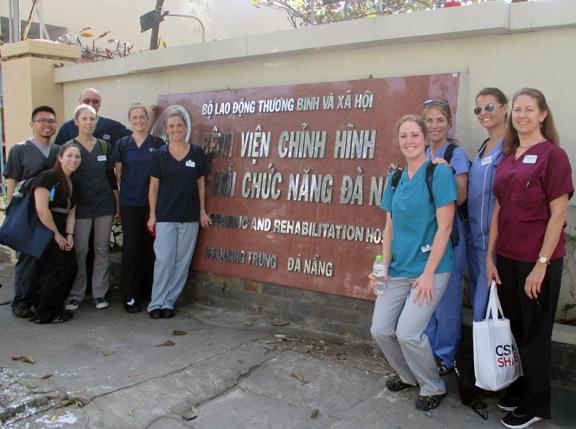To expand the horizons of the students, Beling and fellow PT professor Peggy Roller and 8 graduate students traveled to the city of Siem Reap in Cambodia and Da Nang in Vietnam this winter to evaluate and treat patients in local hospitals. The three week long trip is the capstone event of a course called International Physical Therapy, a cultural competence course designed with a variety of multi-cultural experiences.
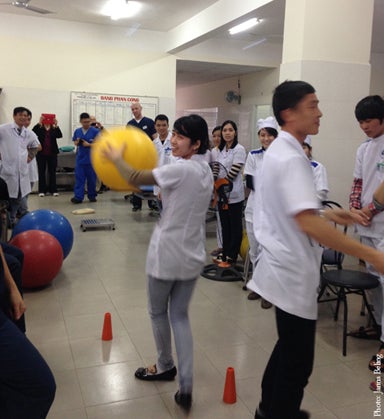
In the early 2000’s, Beling volunteered regularly in countries abroad with Health Volunteers Overseas, a non-profit organization of volunteer physical therapists, physicians, nurses, and dentists that are committed to improving global health through education. Eventually, Beling became Director of the Physical Therapy Program in Vietnam for HVO. In 2009, Beling and Roller started bringing CSUN student groups to Vietnam for immersion study trips. “The hospitals I’d visited were so vastly different from what we can show our students in the US, I knew this affiliation could really strengthen their skills and hone their talents,” Beling said.
From the classroom, students can examine case studies, review videos and interview each other about their backgrounds and experiences. Beyond campus they can experience different ethnic neighborhoods. “In the final semester of the PT curriculum, the students may take the cultural competence elective,” Beling says. “Experiences build over the semester and lead up to the Vietnam trip. We are fortunate to be in the Los Angeles basin because it is so diverse, we have a lot of opportunities to explore. We volunteer at a clinic in Koreatown. Students outline at least one case of a client who has a different culture from their own. This assignment facilitates active discussion about culturally appropriate care. The students learn how to work effectively with a trained interpreter. We visit places like Little Saigon in Orange County and explore ethnic supermarkets and restaurants. A by-product of these experiences is an appreciation for ethnic diversity, food preferences, health beliefs, and neighborhood community programs."
Keren Pinto and Sarah Brady were two of the students who made the international trip this year. “It makes you more open minded and relaxed about meeting patients who are used to different methodologies,” Pinto said. “Realizing that everyone is different and that what they believe about health is true to them, you learn how to go with their experience and bring in new information with tact. If they have an idea you’re not used to it can be challenging, but when you realize you’re resisting the differences, you learn to think of ways to enhance what they know and avoid contradicting them.”
Beginning the overseas trip with a stop in Siem Reap, Cambodia, the group first toured a children’s hospital and then flew on to Vietnam for a two week internship in an orthopedic and rehabilitation hospital. This was Beling's fourth and Roller's third student trip to Vietnam since 2009. had an idea of what to expect, but when the group arrived at the hospital, they were all surprised to be met by hundreds of patients. “It turned out this time our visit had been advertised on TV,” Beling said, “The patients were excited to get evaluation and treatment from American Physical Therapists.”
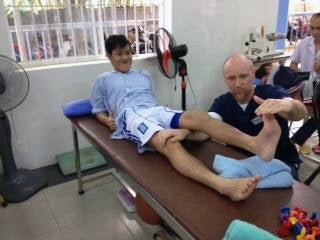 Since the mission of the project is to help patients while providing clinical teaching to the hospital’s physical therapists and students, when the team would arrive in the morning they would teaching topics to and rotate through patient groups to address pediatric, acute and chronic cases. “We would keep our eyes open for teachable moments as we’d practice throughout the day,” Beling said.
Since the mission of the project is to help patients while providing clinical teaching to the hospital’s physical therapists and students, when the team would arrive in the morning they would teaching topics to and rotate through patient groups to address pediatric, acute and chronic cases. “We would keep our eyes open for teachable moments as we’d practice throughout the day,” Beling said.
It took some time to sort out patient needs from the variety of conditions the team saw. “Mostly at first our work was triage,” Pinto said, “Some needed imaging to diagnose their conditions.”
Beling elaborated, “The students really rose to the occasion under sometimes truly difficult situations. They got experience with patients in neurology, orthopedics, pediatrics, the out-patient clinic, and, the prosthetics/orthotics workshop. They observed surgery and half of the students were in a home health experience, too. They saw things they will probably never see again,” she said, “Such as the farmer with a spinal cord injury because her water buffalo gored her.” Students kept a daily reflective journal which was intended to help each student focus, reflect, and deepen learning from their experiences and was a resource for daily end of the day reflection sessions.
The setup of the hospital was completely different than the US standard. "Nurses deliver medications.” Brady said, “However, families take care of the patients. There is no linen service, no meal service. All of this is provided by the families.”
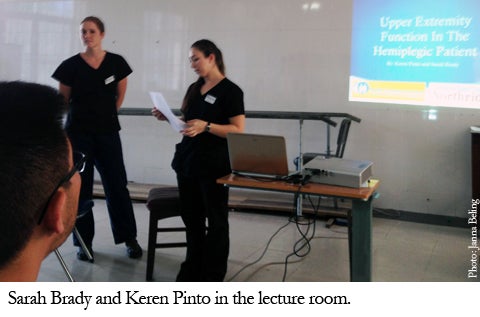
Brady cited a particularly memorable case: “I met a woman who had shrapnel from a grenade in her knee,” she said. “She explained she’d had the injury since the ‘American war.’ Right there is a moment where you stop and consider a difference we’d been taking for granted – of course for the Vietnamese the war was known as the ‘American war’-- she didn’t trust us at first, but it wasn’t long before she was looking forward to seeing us and seeking us out.”
Pinto said she also confronted long term injuries incurred from landmines during (and beyond) the war. “But my first introduction to a patient was a man who had fallen from the 9th floor of construction on the hospital we were in now. He’d gotten a traumatic brain injury. He was the hardest worker I’ve ever seen. He really wanted to overcome his injury.”
In their work with the professionals in the hospital, the CSUN students taught practices for rehabilitation from stroke, traumatic brain injury, and musculo-skeletal injuries. “They weren’t expecting us to do evaluations--that’s not how physical therapy is practiced there,” said Roller, “But we do train our physical therapists to evaluate and treat. So for the Vietnamese practitioners, performing evaluations was a learning point for them.”
Step by step practices were tailored to get patients back into the normal routines of life, such as re-learning skills like grasping and drinking a glass of water. Patients work on their conditions all day, from 8 am to 4pm with short breaks. They walk obstacle courses, march to build endurance, use exercise machines.
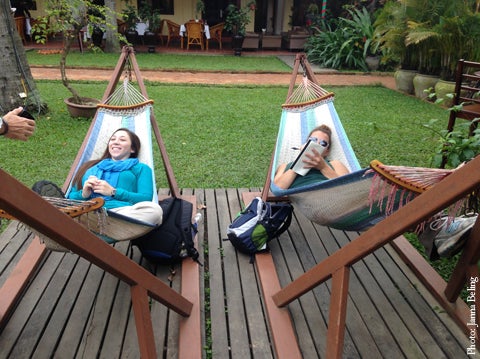
“They make the routine of their therapy part of life and progress is slow,” Brady said, “Since the patients basically live in the hospital, it can be challenging to get them to do things a new way. The language barrier makes it tricky, too, it’s a slow process, but we got through and we also learned a lot from the patients and the therapists.”
The students brought home a wealth of new skills and perspectives thanks to the trip. “A really poignant moment for me,” said Brady, “Was when a woman approached me, her husband was translating. She had been getting cupping done and said it really helped. She had heard people say it was useless, but she believed she was getting a lot out of it. We let her know we were there to get a better understanding. I always want to be like that.”
Beling added, “We want to encourage participation by building on what patients are doing to take care of themselves. Cupping isn’t typically a western practice, but the patient felt it helped her and it doesn’t harm. So we said keep up the good work, and perhaps she might want to add this new approach that we can teach her, too.”
For the future: Sarah Brady sees herself working with athletes after performing a residency. She likes the idea of having a mentor to guide her early practice, Keren Pinto is looking forward to working in outpatient orthopedics, and also wishes to pursue geriatrics. The next group to make the trip will be students from the first Doctoral class, and they will perform doctoral research in collaboration with biomedical engineer, Dr David Reinkensmeyer, from UC Irvine who has developed a resonating arm device for people in third-world countries who have chronic stroke.
On their return to Northridge, Keren Pinto and fellow student Breanna Langel presented their Global Health experiences at the national Physical Therapy conference in Las Vegas. Sarah Brady and Luis Gonzalez both were interviewed for the April issue of Pulse, the online student American Physical Therapy Association (APTA) publication.
Jean O'Sullivan
sp2014

